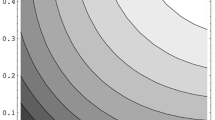Abstract
Statistical disclosure control (SDC) methods aim to protect privacy of the confidential information included in some databases, for example by perturbing the non-confidential parts of the original databases. Such methods are commonly used by statistical agencies before publishing the perturbed data, which must ensure privacy at the same time as it preserves as much as possible the statistical information of the original data.
In this paper we consider the problem of designing distributed privacy-preserving versions of these perturbation methods: each part of the original database is owned by a different entity, and they want to jointly compute the perturbed version of the global database, without leaking any sensitive information on their individual parts of the original data. We show that some perturbation methods do not allow a private distributed extension, whereas other methods do. Among the methods that allow a distributed privacy-preserving version, we can list noise addition, resampling and a new protection method, rank shuffling, which is described and analyzed here for the first time.
Preview
Unable to display preview. Download preview PDF.
Similar content being viewed by others
References
Bunn, P., Ostrovsky, R.: Secure two-party k-means clustering. In: Proc. of CCS 2007, pp. 486–497. ACM Press, New York (2007)
CASC: Computational Aspects of Statistical Confidentiality, European Project IST-2000-25069, http://neon.vb.cbs.nl/casc
Cramer, R., Damgård, I.B., Nielsen, J.B.: Multiparty computation from threshold homomorphic encryption. In: Pfitzmann, B. (ed.) EUROCRYPT 2001. LNCS, vol. 2045, pp. 280–299. Springer, Heidelberg (2001)
Dalenius, T., Reiss, S.P.: Data-swapping: a technique for disclosure control. Journal of Statistical Planning and Inference 6, 73–85 (1982)
Damgård, I.B., Fitzi, M., Kiltz, E., Nielsen, J.B., Toft, T.: Unconditionally secure constant-rounds multi-party computation for equality, comparison, bits and exponentiation. In: Halevi, S., Rabin, T. (eds.) TCC 2006. LNCS, vol. 3876, pp. 285–304. Springer, Heidelberg (2006)
Defays, D., Anwar, M.N.: Micro-aggregation: a generic method. In: Proc. of the 2nd International Seminar on Statistical Confidentiality, pp. 69–78 (1995)
Data Extraction System, U.S. Census Bureau, http://www.census.gov
Domingo-Ferrer, J., Torra, V.: Disclosure control methods and information loss for microdata. In: [10], pp. 91–110 (2001)
Domingo-Ferrer, J., Torra, V.: A quantitative comparison of disclosure control methods for microdata. In: [10], pp. 111–133 (2001)
Doyle, P., Lane, J., Theeuwes, J., Zayatz, L. (eds.): Confidentiality, disclosure, and data access: theory and practical applications for statistical agencies. Elsevier Science, Amsterdam (2001)
Dwork, C.: Differential privacy. In: Bugliesi, M., Preneel, B., Sassone, V., Wegener, I. (eds.) ICALP 2006. LNCS, vol. 4052, pp. 1–12. Springer, Heidelberg (2006)
Dwork, C., Yekhanin, S.: New efficient attacks on statistical disclosure control mechanisms. In: Wagner, D. (ed.) CRYPTO 2008. LNCS, vol. 5157, pp. 469–480. Springer, Heidelberg (2008)
Fouque, P.A., Poupard, G., Stern, J.: Sharing decryption in the context of voting or lotteries. In: Frankel, Y. (ed.) FC 2000. LNCS, vol. 1962, pp. 90–104. Springer, Heidelberg (2001)
Heer, G.R.: A bootstrap procedure to preserve statistical confidentiality in contingency tables. In: Proc. of the 1st International Seminar on Statistical Confidentiality, pp. 261–71 (1993)
Jagannathan, G., Wright, R.: Privacy-preserving distributed k- means clustering over arbitrarily partitioned data. In: Proc. of KDD 2005, pp. 593–599 (2005)
Kim, J.J.: A method for limiting disclosure in microdata based on random noise and transformation. In: Proc. of the ASA Section on Survey Research Methodology, pp. 303–308 (1986)
Lane, J., Heus, P., Mulcahy, T.: Data access in a cyber world: making use of cyberinfrastructure. Transactions on Data Privacy 1(1), 2–16 (2008)
Nin, J., Herranz, J., Torra, V.: Rethinking rank swapping to decrease disclosure risk. Data & Knowledge Engineering 64(1), 346–364 (2008)
Paillier, P.: Public-key cryptosystems based on composite degree residuosity classes. In: Stern, J. (ed.) EUROCRYPT 1999. LNCS, vol. 1592, pp. 223–238. Springer, Heidelberg (1999)
Schoenmakers, B., Tuyls, P.: Efficient binary conversion for Paillier encrypted values. In: Vaudenay, S. (ed.) EUROCRYPT 2006. LNCS, vol. 4004, pp. 522–537. Springer, Heidelberg (2006)
Author information
Authors and Affiliations
Editor information
Editors and Affiliations
Rights and permissions
Copyright information
© 2010 Springer-Verlag Berlin Heidelberg
About this paper
Cite this paper
Herranz, J., Nin, J., Torra, V. (2010). Distributed Privacy-Preserving Methods for Statistical Disclosure Control. In: Garcia-Alfaro, J., Navarro-Arribas, G., Cuppens-Boulahia, N., Roudier, Y. (eds) Data Privacy Management and Autonomous Spontaneous Security. DPM SETOP 2009 2009. Lecture Notes in Computer Science, vol 5939. Springer, Berlin, Heidelberg. https://doi.org/10.1007/978-3-642-11207-2_4
Download citation
DOI: https://doi.org/10.1007/978-3-642-11207-2_4
Publisher Name: Springer, Berlin, Heidelberg
Print ISBN: 978-3-642-11206-5
Online ISBN: 978-3-642-11207-2
eBook Packages: Computer ScienceComputer Science (R0)




